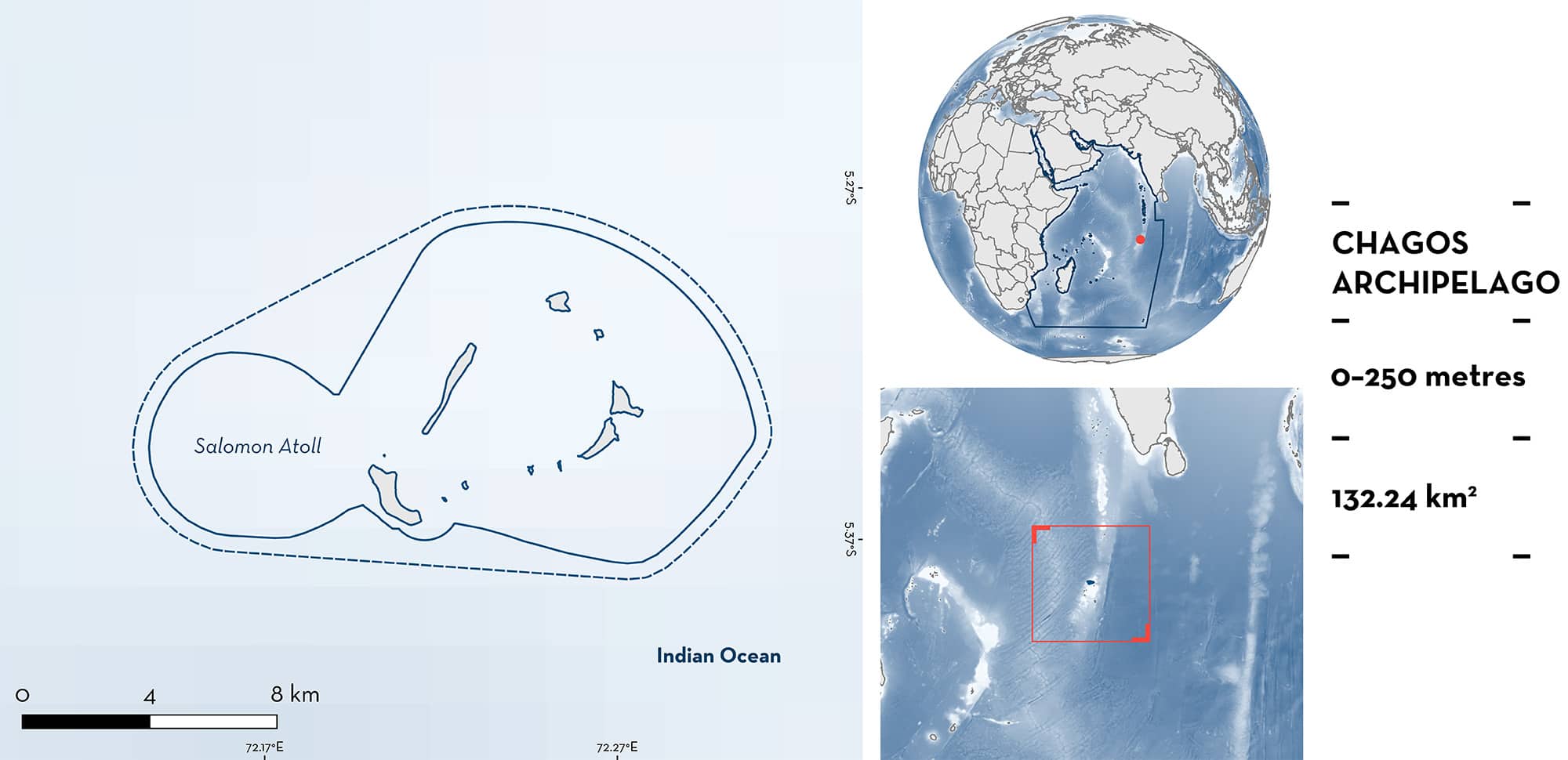ISRA FACTSHEETS
ISRA FACTSHEETS
WESTERN INDIAN OCEAN REGION
Salomon Atoll
Summary
Salomon Atoll is located in the Chagos Archipelago. This area has 11 islands distributed around its rim, an enclosed lagoon, and a single shallow channel on its northern side. Habitats include fringing and patch reefs, and seagrass beds. This area is under the influence of the Indian Ocean monsoon seasons. Salomon Atoll sits within the British Indian Ocean Territory Marine Protected Area. Within this area there are: threatened species and feeding areas (Reef Manta Ray Mobula alfredi).
Download factsheet
Salomon Atoll
DESCRIPTION OF HABITAT
Salomon Atoll is located in the Chagos Archipelago. It lies ~35 km north from the Great Chagos Bank. The Chagos Archipelago is one of the most remote coral reef ecosystems on the planet. Its climate is tropical and moderated by trade winds (Eisenhauer et al. 1999). This area is exposed to strong persistent distant-source swells during the southeast monsoon (April to November). The northwest monsoon (December to March) is dominated by light north-westerly winds, higher rainfall, and warmer temperatures. The islands of the Chagos Archipelago are low lying (only 2–5 m above sea level) and are typically coral cays constructed of limestone with underlying freshwater lenses sustained by rainfall (Sheppard 2007; Graham et al. 2009; Purkis et al. 2016). Salomon Atoll is located east of Peros Banhos Atoll and has 11 islands distributed around its rim. Habitat across the atoll consists of fringing reef, lagoon, patch reef, and seagrass habitats. The Salomon lagoon is largely enclosed and has a single, ~1.2 km long, shallow channel on its northern side (Rayner & Drew 1984).
The area sits within the British Indian Ocean Territory Marine Protected Area.
This Important Shark and Ray Area is pelagic and is delineated from surface waters to a depth of 250 m based on the bathymetry of the area.
CRITERION A
VULNERABILITY
The one Qualifying Species within the area is considered threatened with extinction according to the IUCN Red List of Threatened SpeciesTM. The Reef Manta Ray is assessed as Vulnerable (Marshall et al. 2020).
CRITERION C
SUB-CRITERION C2 – FEEDING AREAS
Salomon Atoll is an important feeding area for one ray species.
From February 2013 to April 2016, Reef Manta Rays were tagged in Egmont Atoll (n = 18) and Salomon Atoll (n = 8) by free-divers with acoustic tags (n = 21; Andrzejaczek et al. 2020). An array of 52 acoustic receivers were deployed between 2014 and 2016 at nine sites and were typically placed on the fore reefs of atolls at depths of 15–20 m. Of these, 13 were deployed among the southern atolls and banks of the archipelago (Egmont Atoll, South Great Chagos Bank, Schwartz seamount) and 39 were deployed among the northern atolls (Peros Banhos and Salomon Atolls, Speakers, North Great Chagos, Victory Bank, and Colvocoresses Reef).
Based on frequency of detections of tagged Reef Manta Rays downloaded from the receiver array in July 2019, the area of highest activity was Salomon Atoll (Andrzejaczek et al. 2020). Given that the receiver within the lagoon at Salomon Atoll is located next to the channel that feeds a strong current from outside at high tide, and that several Reef Manta Rays have been observed feeding at the channel mouth (R Schallert pers. comm. 2023), this site represents an important foraging ground for Reef Manta Rays in the Chagos Archipelago, attracting aggregations of individuals when conditions are suitable.
Download factsheet
SUBMIT A REQUEST
ISRA SPATIAL LAYER REQUEST
To make a request to download the ISRA Layer in either a GIS compatible Shapefile (.shp) or Google Earth compatible Keyhole Markup Language Zipped file (.kmz) please complete the following form. We will review your request and send the download details to you. We will endeavor to send you the requested files as soon as we can. However, please note that this is not an automated process, and before requests are responded to, they undergo internal review and authorization. As such, requests normally take 5–10 working days to process.
Should you have questions about the data or process, please do not hesitate to contact us.


